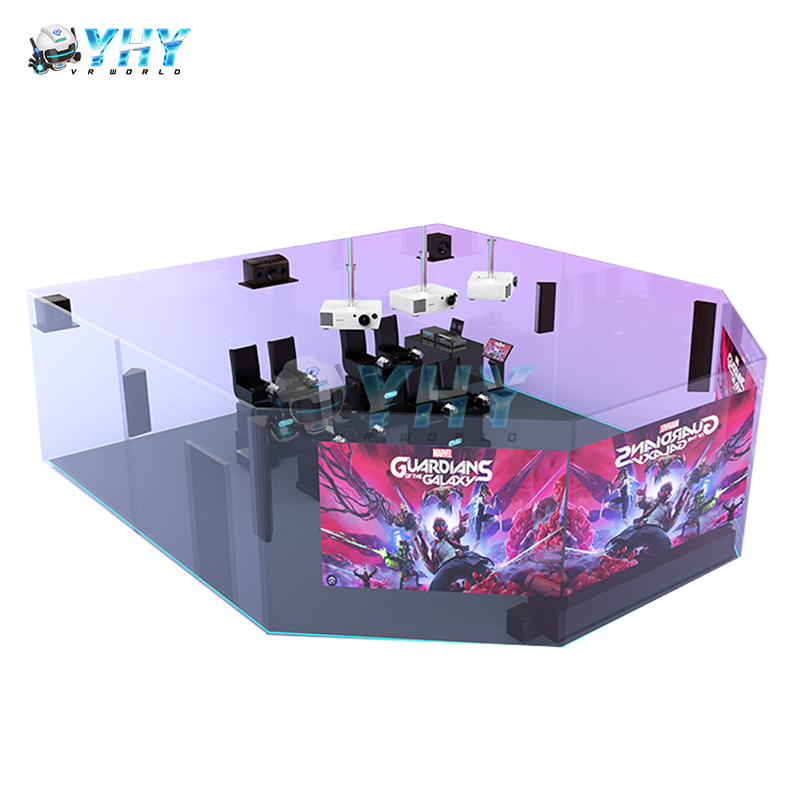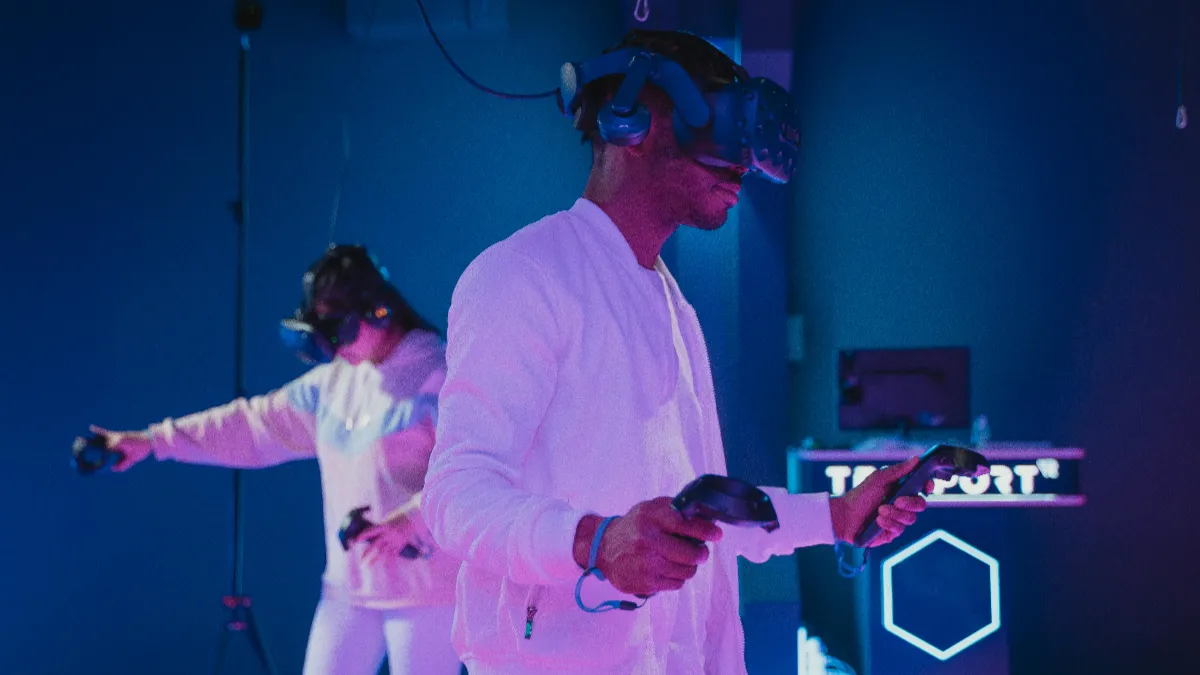Over the past decade, virtual reality has shifted from a futuristic concept into a commercially viable technology, finding applications in gaming, educação, treinamento, and immersive entertainment. But in 2026, with the VR industry maturing and competition intensifying, the question many potential investors are asking is: is it still a good time to invest in VR?
Neste artigo, we’ll explore the business case for VR investment, the costs and ROI of launching a VR business, and why motion simulators are one of the most profitable segments of the industry.
Is VR Still a Good Investment in 2026?

Sim, virtual reality remains a strong investment opportunity in 2026—especially for those targeting the location-based entertainment sector. With steady market growth, affordable hardware, and rising consumer demand, VR continues to offer scalable business potential.
VR Market Growth Remains Strong
De acordo com Statista, the global VR industry is expected to grow from $28.42 bilhão em 2023 para $57.55 bilhão por 2027, with an annual growth rate of over 18%. This expansion spans beyond gaming, with increasing adoption in training, educação, and public entertainment spaces.
Lower Costs Make Entry More Accessible
Launching a VR business is now more affordable than ever. Standalone headsets like Meta Quest 3 and PICO 4 no longer require high-end PCs. Entry-level motion simulators cost as little as $6,000, making it easier for small businesses to get started.
Consumer Demand for Immersive Experiences Is Rising
Post-pandemic shifts in entertainment habits have increased demand for physical, experiências imersivas. Younger audiences, especially Millennials and Gen Z, are more likely to pay for interactive, short-form experiences that offer excitement and novelty.
Is VR a Good Fit for YOU?

Before jumping into the numbers and profit models, it’s important to ask a more personal question: Is investing in VR the right move for you?
The VR business isn’t a one-size-fits-all opportunity. It’s an industry that rewards hands-on operators, location-aware planners, and business owners who are willing to evolve with technology. If you’re exploring low-maintenance, passive income models, VR might not meet your expectations. But for those who see value in experience-based engagement, especially in public spaces, the opportunity is real.
You may be a good fit for a VR business if:
You own or can access a space with steady foot traffic (Por exemplo, mall kiosk, tourist attraction, event venue)
You’re looking for a scalable business you can start with a modest budget
You’re open to learning basic tech operations or hiring light support staff
You value repeatable, short-session experiences that can generate revenue daily
Por outro lado, VR may not be for you if:
You expect passive income without involvement
You don’t have a realistic plan for bringing users to your location
You dislike managing any physical equipment, maintenance, or software updates
If you find yourself in the first group, the next step is identifying which type of VR business model gives you the best chance at success. For many first-time investors, the answer lies in VR motion simulators—which we’ll explore next.
What Makes VR Motion Simulators a Profitable Choice for Business Owners?

Not all VR investments are equal. One of the most profitable sectors is VR motion simulators—machines that combine virtual visuals with physical movement to create fully immersive experiences.
Why VR Simulators Make Business Sense:
- High Ticket Price per Experience: A typical ride in a VR motion simulator can charge $5–$15 for a 3–5 minute session, making them ideal for high-foot-traffic venues like malls, atrações turísticas, and entertainment centers.
- Small Footprint, Big Impact: A single 3DOF/6DOF simulator takes less than 2 sqm, yet delivers cinematic, multi-sensory experiences rivaling large theme park rides.
- Low Staffing Requirements: Unlike escape rooms or traditional amusement setups, one staff member can manage multiple simulators, reducing operating costs.
- Modular, Scalable Business Model: Start with 1–2 simulators and expand as revenue grows. Great for incremental investment.
- High Repeat Rates: With a library of rotating VR content (montanhas -russas, corrida, horror, space exploration), you can drive repeat visits.
How Much Can You Earn from a VR Motion Simulator Business?

A common concern among new investors is whether a VR business can generate real returns without massive upfront costs. The answer is yes—especially when you adopt a lean, modular VR simulator model.
Below is a real-world comparison between a YHY 40㎡ VR Park Setup and a Traditional 100㎡ VR Park Setup, showing both investment and expected returns:
| Key Metric | YHY VR Park (40㎡) | Parque VR tradicional (100㎡) |
| Number of Simulators | 16 | 8 |
| Equipment Cost | $59,135.86 | $60,800 |
| Aluguel do local | $2,760/mês | $6,900/mês |
| Staff Required | 2 | 4 |
| Labor Cost | $965/mês | $3,860/mês |
| Monthly Turnover | $96,000 | $66,000 |
| Annual Revenue | $1,152,000 | $792,000 |
| Space Efficiency | 2.5× more devices per ㎡ | Baseline |
| Estimated ROI Period | 6–10 meses | 12–18 months |
Why the YHY Model Outperforms Traditional VR Setups
The YHY VR park model is built for maximum space utilization and throughput. Com 16 motion simulators in just 40㎡, each 3–5 minute ride is priced between $5–$15, allowing hundreds of sessions daily. This setup:
- Reduces startup investment by avoiding oversized layouts and unnecessary staffing
- Doubles your earning potential per square meter
- Shortens the breakeven period to under 1 year in most cases
- Enables fast scaling—you can add units modularly as traffic grows
Instead of committing to large commercial leases and high payroll, business owners can start lean and expand based on performance. This flexibility makes the simulator model ideal for malls, tourist zones, FECs, and even mobile pop-up events.
Learn more about this model here: YHY’s VR Theme Park Profitability Blueprint.
Real-World Success: How YHY VR Simulators Deliver Immersive, Profitable Experiences
YHY’s VR solutions have been deployed globally, from historical landmarks to cutting-edge entertainment centers. Below are two standout case studies showcasing how our simulators are transforming both user experience and business profitability.
Case Study 1: “Great Wall Crossing” — Beijing, China
Located at the Shuiguan section of the Great Wall, this educational VR installation features 20 exclusive “Fantasy Source Crossing” simulators powered by SIM’s patented 3DOF motion platform and PICO Neo 3 Fones de ouvido VR. With precise motion matching and an all-aluminum structure, the “Ultimate Crossing” chair immerses visitors in a dynamic flyover experience across China’s ancient wonder.
The installation has attracted thousands of tourists monthly, turning a historical site into a high-revenue educational attraction. Its replayable content and family-friendly theme have driven strong repeat traffic and long-term returns, especially during peak tourism seasons.
Case Study 2: YHY VR Theme Park — United Kingdom

As the UK’s first full-sensory VR theme park using YHY’s exclusive tech, this center features YHY Racing, Tiro de VR, and other custom-built simulators. The venue blends next-gen hardware, original multiplayer games, and social VR elements to deliver a truly immersive entertainment destination.
Since launch, the park has become a go-to spot for families, jogadores, e formação de equipes corporativas. With flexible ticket pricing and multiple revenue streams, it has achieved strong operational profitability, and continues to expand based on demand.
Types of VR Motion Simulator Machine You Can Choose for Your Business
Here are three leading YHY VR motion simulator series you can consider for your business: Cruzamento, Corrida, and Flight.
YHY Crossing Series
The YHY Crossing series delivers an immersive journey-based experience using YHY’s patented 3DOF motion platform and high-quality VR headsets like the PICO Neo 3. Designed for educational and leisure venues, Cruzamento 1 e Cruzamento 2 models cater to group content such as historical tours or adventure sports. The aluminum-alloy chairs are compact, durable, and support simultaneous multi-device operation—offering scalable, repeatable storytelling experiences with dynamic motion synchronized perfectly to VR visuals.
YHY Racing Series
Perfect for arcades and esports lounges, o YHY Corrida series blends panoramic triple-screen display with a responsive 3DOF motion platform and realistic force‑feedback controls. Models include the standard Racing unit, Racing VR (with PICO Neo headset), and the Racing Pro (with MOZA wheel, shifter, e freio de mão). Premium aluminum construction, ergonomic racing seats, and multiplayer support make this series ideal for competitive sim-racing experiences.
YHY Flight Series
O Voo YHY series caters to aviation enthusiasts and simulation centers, offering authentic flying experiences via a robust 3DOF motion platform with roll, tom, and yaw movements. Supported by triple-screen and equipped with flight control joysticks, this series lets users feel every maneuver realistically. Constructed with aluminum alloy and stainless steel, it delivers dependable performance suitable for medium-to-high throughput venues.
How to Choose the Right VR Motion Simulator for Your Business
Selecting the right VR motion simulator goes beyond choosing a popular model—it requires aligning the equipment with your business goals, space limitations, and customer expectations. Here are the key factors to consider:
1. Business Scenario and User Experience
Are you aiming for family entertainment, tourist interaction, educational content, or competitive gaming? Choose a simulator that matches your use case and target audience preferences.
2. Space Availability
Some simulators need just 2–3㎡, while others with triple-screen or full cockpit setups may require 5㎡ or more. Accurately assess your venue to ensure optimal layout and safety.
3. Budget and ROI Expectations
Your investment should balance quality and return speed. Entry-level simulators start around $4,000, but higher-end models offer richer interaction and longer lifespan.
4. Content Flexibility
Choose systems that support multiple game types or can update content periodically. This helps extend replay value and attract repeat customers.
5. Maintenance and Operational Simplicity
Look for durable construction, easy calibration, and minimal staffing needs. The more streamlined the daily operation, the lower your long-term overhead.
Should I Invest in VR Gaming Business Now or Wait? Pensamentos finais
If you’re considering entering the VR gaming market, there’s no better time than now. With growing demand for immersive entertainment and lower entry barriers, early movers stand to gain the most.
Em YHY, we support your business from the ground up. Our simulators are powered by exclusive 3DOF motion technology—delivering highly accurate movement that enhances immersion and helps reduce VRmotion sickness. Every unit is fully customizable to match your brand or venue needs.
Even after installation, we stay with you. All YHY products come with free game updates, technical support, and ongoing system upgrades, giving you a true one-stop service experience.
Need help choosing the right VR equipment for your business?
Contact our team for a free consultation and business plan support.
Perguntas frequentes
1. Is it profitable to start a VR arcade in 2026?
Sim. With increasing demand for immersive entertainment and declining hardware costs, many VR arcades can achieve ROI within 6–12 months—especially those using modular simulators with high session turnover.
2. What makes YHY simulators different from others on the market?
YHY simulators feature exclusive 3DOF motion technology for smoother, more accurate movements. They’re also optimized to reduce motion sickness and come with custom content, free game updates, and full technical support.
3. Can I customize the simulator design for my venue or brand?
Absolutamente. YHY provides full customization options, including exterior design, branding elements, and localized content to help you create a truly differentiated experience.
4. Does VR have a future?
Sim. VR is rapidly expanding across gaming, educação, e turismo. With improved hardware like YHY’s 3DOF motion platform and rising demand for immersive experiences, VR is now a scalable business.














